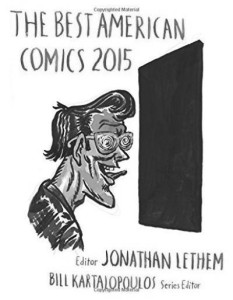Picking Sides in Comics: If Comics Are Literature, Why Don't I Feel like a Writer?
 Laura Kenins is this month's guest editor for The Town Crier
Laura Kenins is this month's guest editor for The Town CrierHoliday and birthday money never came with the stipulation not to spend it on comics in our house (although it did come with a ban on video games, which I always found strange, as we never owned a video game console). My dad was often an enthusiastic reader of our Archie comics after (or before) we’d finished with them. I got in trouble no matter what my choice of after-bedtime reading material was. So—perhaps taking into account that this father spent my entire childhood reading the same book—I may have missed the memo that comics weren’t literature.
I started picking up zines and self-published comics off of battered racks at the backs of book and music stores in high school. I’d been making fun of my classmates and people with bad music taste (the two admittedly indistinguishable by high school) in my sketchbook since junior high, but the first time I made something that could be shared in all its photocopied glory was when my English teacher gave the open-ended assignment to “make something about Hamlet” and I knew right away: I’d draw an issue of teenage Hamlet’s comic zine about his life.After that, I was hooked. My next comic wound through Dante, James Joyce, and Greek mythology. It wasn’t clear to me yet that my work had little literary merit.
A few years and piles of rejection letters from lit magazines and publishers for work I’d variously described as “a collection of short stories,” “short story in comic form,” “graphic short story,” and so on, I got the message. Plenty of these publications have since embraced comics, but I’m still apprehensive about them. They're like a jerk you meet at a party who won’t give you the time of day until they realize you work for some publication or you’re a friend of the cool people. Despite the increasing numbers of comics and graphic novels landing in book prize nominations and on best-of lists, or featured in book review sections, we’re still not really sure if we want to call graphic works literature. And who’s surprised, when so many creators hold more weight in the visual arts sphere than the literary world? Nobody’s keeping track, but if you did a survey at TCAF any year, I’d venture a guess you’d find more creators with connections to OCAD and other visual arts departments than degrees in English lit or writing careers.Still, nobody’s sure where their loyalties lie: English majors who make comics fear their lack of visual arts training or ability, and trained illustrators feel more at ease at a gallery opening than a poetry reading. You’re unlikely to run into someone who tells you their background is in comics, as it’s still not possible to complete any kind of university-level specialization in comics in Canada, despite expanding numbers of individual classes and a handful of college programs appearing.
When we view comics through the lens of literary culture, we’re asking creators working in a visual form to fit into a series of standards set by poets, novelists, and journalists—standards that aren’t necessarily relevant to comic creators’ work.
Call comics literature all you like, but I’m not holding my breath for an editor, English professor, selections committee, or grant jury to agree when I send them my work if the word “comics” isn’t explicitly stated. Even if it is, they might actually be art, or the publication’s one-comic quota for the year might have been filled already, or they might not be literary enough, or whatever other excuses relegate comics to a sort of quasi-genre-fiction status in literature.
But if you make comics and illustrate for a living, who cares if poets and city hall reporters don’t take you seriously as a writer? Not all countries’ comic cultures require shoving creators into an art or literature boxes. For example, Franco-Belgian and Japanese traditions are more likely to put them into a box of their own. You might have read Finnish comics in English translation thanks to the Finnish Literature Exchange’s generous grants. The Helsinki Comics Festival makes heavy use of a network of small galleries for its programming and the comics newspaper, Kuti, takes its art so seriously that contributors draw all of the ads.
 The cover of The Best American Comics 2015
The cover of The Best American Comics 2015In North America, we’re still stuck on dividing our culture into that which fits into a gallery, that which fits into a book review section, and that which fits into a rack at the convenience store. But outside of this, creators and publishers are crafting a world of their own. One artist might create an installation piece during downtime after their book that was nominated for a fiction award while moonlighting for Marvel to pay the bills; another artist with a 300-page graphic novel on history shares a table at a festival with her best friend whose zines have their roots in graffiti art; a teenager whose dream is drawing the new great webcomic takes his inspiration from Jean-Michel Basquiat.
Divides blur easily among actual comics creators, their work, and alliances. Take Toronto-based Koyama Press: artists like Michael DeForge and Jesse Jacobs make best book lists, and the press’s spring catalogue includes a monograph by Rokudenashiko, the Japanese artist who faced obscenity charges for crafting a kayak modelled after her own vagina. Even Canada Council is acknowledging that its creativity divisions are behind the times, with major grant changes coming next year.
As I planned this month’s content for The Town Crier, The Best American Comics 2015 anthology was released (American refers to all of North America here, for those unaware). In his introduction to the anthology, comics critic and series editor Bill Kartalopoulos looks straight at this disconnect:
“Comics should have the capacity to appear alien and difficult to assimilate within literary publishing. It is an expression of what they are. To expect comics to function merely as colorful, illustrated cousins of conventional narrative fiction is a profound and wasteful act of self-denial.”
Flipping through the author bios of the anthology, you’ll find piles of BFAs, MFAs, and visual arts schools and departments. “Young cartoonists no longer feel alienated from the traditional fine arts, even if they operate outside of their institutions,” Kartolopoulos writes. However, those institutions’ relationship to cartoonists is another story.
On the other side of the debate, last week The National Post told us the battle over whether or not comics are literature has been won because Alison Bechdel’s Fun Home is a musical and comic shops aren’t scary any more. I’d like to think we can make the conversation a bit more nuanced than that, and maybe I’m not interested in winning the battle. It’s precisely the space comics occupy between art and literature that appeals to me; that I can feel at home in a gallery or library, and at times out of place in either.
Whatever comics are, there are plenty of conversations we should be having in comics criticism. Over this month at The Town Crier, we’ll look at topics from grants for making comics in Canada to money and recognition; from identity in Quebecois comics to race in Mexican comics. One thing is clear: we do need to make a space for comics, wherever we put them, because they’re certainly not going anywhere.
Laura Kenins is a writer, editor, and comic artist currently based in Halifax, NS. Her comics and writing have appeared in kuš! comics, Truthout, The Coast, Quill and Quire, THIS Magazine, and elsewhere. Find Laura’s work online or follow her on tumblr.


